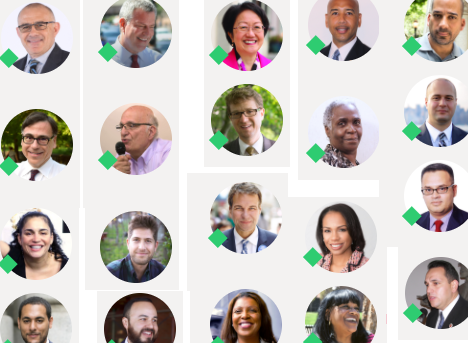
NYC CFB
Just a few of the candidates on the ballot September 12.
Let’s challenge a popular campaign 2017 narrative right now, the one about how this is a dull election year lacking in competitive or compelling races and sure to generate record-low turnout. The first part is not true, and the second part is only a guarantee if we all keep repeating the first part.
The fact is there are interesting and important races all over the city.
The Democratic primary for mayor is very unlikely to result in an upset victory (although Mayor de Blasio himself did raise that possibility over the weekend) but will provide a gauge of just how many New York Democrats are upset enough about the mayor’s fundraising or housing policies or criminal-justice posture—to name just three of the areas in which resentment of the mayor from within his base has supposedly been brewing—to bother voting.
At a time when law, order and justice are fraught topics, one of the biggest elected law-enforcement jobs in the country is up for grabs as Brooklyn Democrats nominate someone to permanently replace the late Ken Thompson.
Meanwhile, in the City Council, the seven seats that we knew would be forced open by term limits are not the only ones where there’s a race worth watching on September 12. Three other seats are now open, as well, thanks to two Councilmembers (she and he) leaving voluntarily and one departing in handcuffs; two of those races will see primary contests. And at least nine incumbents face what appear to be serious challenges.
Needless to say, the other contested primaries are also not faits accomplis. There are races for public advocate and Bronx borough president and 15 other Council seats, not to mention judicial and party posts. Most of the action is on the Democratic side but Republicans and Greens are in the mix, too. Of course, the real decision is made on November 7, although the primary does usually frame the general election rather decisively in New York. And remember: All those Council races set up the election after the election, to see who is the next Council speaker.
City Limits has teamed up with WNYC and Gotham Gazette to cover these exciting races and inform voters about all the choices that confront them in 14 days. Sign up for our free election newsletter, check out our Election Watch site and use the voters’ guide below.
Also out on Tuesday: The official Campaign Finance Board Voters’ Guide, also worth a good look.









3 thoughts on “New Voters’ Guide: Everything You Need to Know About the 2017 Primary”
I did not run for city council in 2013, rather, I chose to defend the political control of Council District 7’s citizen voting age plurality, Black American, when the city council lines were being redrawn. It took me 6 months to prepare a 150 page document challenging the New York City Districting Commission’s decision to retrogress District 7’s citizen voting age plurality, Black American, that went all the way up to the Department of Justice.
Although I did not prevail, the city did admit that retrogression did happen through such redistricting within the Black population in the 7th District.
And I ran for city council in the 7th Council District in 2009.
My updated Bio…
Julius Tajiddin, a South Bronx-born Harlem resident, credits his time at Hunter College, law school, the Military and the Job Corps as preparation for his life of social and civic engagement for community improvement and empowerment. His participation at the historic Million Man March in Washington, D.C., in 1995 and early encouragement from NYS Assemblywoman Inez Dickens led him to finally take the plunge into public service.
Julius quickly learned how to navigate the NYC bureaucracies, judicial system, private sector, and the publicly-elected politicians’ offices as he became involved in many well-publicized Harlem projects related to education, housing and urban development, including negotiating community gains in the 125 Street River to River Rezoning to slow gentrification, by keeping luxury and skyscrapers out of the core district area.
As a community leader, counselor, and volunteer, Julius joined CB 9’s Ad Hoc Community Benefits Steering Committee to establish a viable Community Benefits Agreement between Columbia University and Manhattanville Residents as compensation for Columbia’s campus expansion and built close alliances with Community Board, 10 earning appointments to its Education and Libraries, Land Use, Housing and Landmarks Committees. As a parent leader and Chairman of the Frederick Douglass Academy 2 School Leadership Team and co-chairman of the Wadleigh Campus Leadership Team he helped organize parents and community groups to stop or delay charter school co-locations in Harlem and throughout the city and was chiefly instrumental in preventing the closure of Wadleigh and FDA 2’s middle schools.
He helped form the Save Harlem Now Coalition to help tenants secure injunctions to prevent their illegal evictions. Julius continues to provide counsel to residential and commercial tenants in disputes with landlords.
Working closely with tenants, Julius fought against an unjust NYCHA plan in 2008 to transition 8400 housing units into the Section 8 program which led to NYCHA withdrawing the plan. This led to saving approximately 24,000 tenants from losing their apartments. Also that year he successfully negotiated with DHCR officials to change an unconstitutional Preferential Rent Policy. This kept over 30,000 Rent Stabilized apartments from being deregulated. Julius has also successfully reached out to Blood and Crip gang members initiating solutions to reduce gang violence in Harlem.
Julius’s extensive on-going community volunteer work has also included: helping to create the city-wide Neighborhood Coordinating Officer Community Policing Program as an alternative to Stop and Frisk; helping Malcom X’s family retrieve papers and memorabilia that were being scheduled by eBay; co-founding Harlem4Obama and orchestrating a then Senator Barack Obama’s historical appearance for a fund-raising event at the World Famous Apollo Theater – “A Night at the Apollo” in 2007.